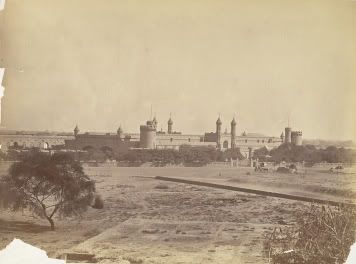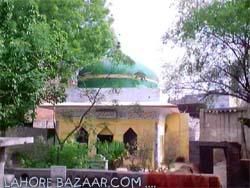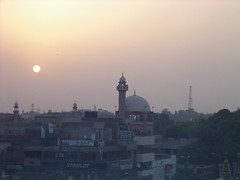Guest post by Raza Noor
(based on original by Majid Sheikh)
The area of Garhi Shahu in Lahore has many a fond memories for me because I spent my childhood running around in its small streets. I recently found this wonderful article on Garhi Shahu written by Majid Sheikh in Dawn in 2002. This post is a blog version of that article, adapted to a blog format and with some updates by me.

Lahore, definitely has a rich historical past and when talking about Garhi Shahu, one cannot forget but mention the railway station, or the Christian community, or the Burt Institute or that wonderful dance club (Nautch Ghar) that no longer functions. Then there are also the Convent of Jesus and Mary, the Jamia Naimia Mosque, and the Taj and Crown cinemas but surely there is much more to this place than we have ever cared to explore.
Garhi Shahu reached its pinnacle of fame during the British period with the laying of the railway track. At the time, being an engine driver was the ‘in thing’. Initially, all the engine drivers were British for whose accommodation, the Raj laid out beautiful residential colonies near the rail track. Many of the spacious colonies still exist as reminders of favors bestowed upon its employees by the Raj. There is the still superb Mayo Gardens, the Burt, and also other colonies on both sides of the old Mayo Road, now renamed after Allama Iqbal. Another part of our history lost to the nationalistic fervor of renaming roads and localities.
As the railways grew, the British then started hiring Indian Christians, mostly of Portuguese origin from Goa and soon Lahore became filled with D’Souzas, D’Sylvas and Ferrairas, alongside the fairer skinned British origin names like Burtons, Brians, and Nibletts.
The new recruits were also inducted into the railway police, and later on into the Punjab police, where they all served this city with distinction. During that time, the social and cultural environment of Garhi Shahu was markedly different from the rest of Lahore, making it a much sought after area. Today, you will be hard pressed to find any of these names here, as almost all of them have for valid reasons “flown to cooler climes�.
But then the real story of the area must begin a long time before the Raj during the days of Emperor Shah Jehan, for during his reign an Arab sage by the name of Abul Khair came  to Lahore on his travels from Baghdad. In those days, the area now known as Garhi Shahu was known as Mohallah Syedan, because in this area lived scholars like Syed Jan Muhammad Hazuri, after whom is named the famous Hazuri Bagh. Abul Khair was a well-known scholar of Islamic jurisprudence and upon reaching Lahore, found the intellectual environment of Garhi Shahu much to his liking and decided to settle down here.
to Lahore on his travels from Baghdad. In those days, the area now known as Garhi Shahu was known as Mohallah Syedan, because in this area lived scholars like Syed Jan Muhammad Hazuri, after whom is named the famous Hazuri Bagh. Abul Khair was a well-known scholar of Islamic jurisprudence and upon reaching Lahore, found the intellectual environment of Garhi Shahu much to his liking and decided to settle down here.
During the reign of Aurangzeb, the fame of Abul Khair spread far and wide. The emperor ordered that a madressah be built for Abul Khair and a suitable residence be arranged for the scholar. A firmaan or a Royal Order was also issued instituting a maintenance allowance for the upkeep of the house and the madressah and so Abul Khair’s institution was founded. For some time after that, the area was also known as Khairabad. Today, the madressah is but a hoary ghost of its former splendor. It lies empty and derelict on one edge of a small graveyard at the end of a small lane as the road curves towards the main Garhi Shahu chowk.
Abul Khair taught in his madressah till the age of 105, and on his death he was buried here, as were other well-known persons of that age. As the Mughal Empire was folding and anarchy was slowly settling in, scholarship and learning were no longer on a premium. Before Maharaja Ranjit Singh came to power in 1799 and finally managed to bring order for 40 odd years, Lahore was ruled by a triumvirate of Sikhs of dubious distinction for about 30 years. During this period, anarchy reigned supreme and the madressah was taken over by a khalifa by the name of Muhammad Naeem, who taught there but on his death there was a void.
 But as we all know, anarchy has rules of its own, and it knows how to fill in voids on its own accord, just like in our times ‘qabza groups’ make a mockery of the law, in a way very little has changed. Abul Khair’s house and madressah had many scoundrels with an eye on it. As was the fate of many other historical buildings in the area, people started stealing bricks from the buildings of the madressah. Students of the madressah were constantly harassed by groups of dacoits and stripped of their meager belongings.
But as we all know, anarchy has rules of its own, and it knows how to fill in voids on its own accord, just like in our times ‘qabza groups’ make a mockery of the law, in a way very little has changed. Abul Khair’s house and madressah had many scoundrels with an eye on it. As was the fate of many other historical buildings in the area, people started stealing bricks from the buildings of the madressah. Students of the madressah were constantly harassed by groups of dacoits and stripped of their meager belongings.
Then came a real godfather by the name of Shahu, and along with his gang of rustlers, he took possession of the buildings meant to accommodate Abul Khair and his scholars. His gang went on a rampage, stealing cattle and other valuables from the area which they then hid in the madressah for safekeeping. If the owners demanded their possessions back, they would return them for a small price otherwise, they would sell their goods.
This was the age when Lehna Singh, Suba Singh, and Gujjar Singh (the three rulers of Lahore) were restricted to their small domains. In between there was no law. The gang of Shahu ruled supreme, and it was from him that the name Garhi Shahu came. The Sikhs started calling it by this name, so did the British when they arrived, and so do we, and “there seems no reason why we should change its name just because Mr. Shahu was a shady character and lived a life very much like many a ‘respectableà¢Ã¢â€šÂ¬Ã¢â€žÂ¢ citizen these days, and one does not say this in jest.â€Â?
The British changed the character of Garhi Shahu, for it was the hub of their entire effort to provide their forces and subjects with a means of communication that revolutionized life in a major way. “But who would have ever thought that an area that came up to accommodate a most learned man never kept his name, and a complete scoundrel managed to keep his name alive because he was a genuine ‘qabza group’ leader. Strange are the twists of fate that we see in Lahore, for every brick has a story to tell.�
The historical photograph of the Railway Station at Lahore, Pakistan was taken by George Craddock in the 1880s and is part of the Bellew Collection of Architectural Views.
Raza Noor has a passion for exploring the history of Lahore, which he does on his dedicated Lahore website and also on Metroblogging Lahore.



















































I am living in karachi but i have visit many time lahore this is my favrioute city not in pakistan in all of the world. The people of lahore are very coprative. and foods aof lahore is very tasty i love to watching Badshahi Mosque and Red fort.
i had spend my 14 years in ghari shahu railway houses, when we went to that place i was 7 years old and didnt knew how to cross the roads by my own till the time when i was 21 and use to drive on same roads.
we left the place in 2004 and now we live in mayo gardens.. we use to play cricket on the main road when the pull was underconstruction.. and i reckon at burt cricket area mohammad yousaf used to play..
i still go to ghari shahu for rabri milk of hafiz and sometimes the fish of sadiq.. love the food there, ras malaies, samosas and shakes and burgers.. everything ..
[…] Who was Pir Mangho? This is a question shrouded in mystery which is laced with both myths and facts. The myths seem to have an upper hand on facts. Among all other things it is also not clear that who is actually buried in the shrine. Is it some saint called Sakhi Sultan or a saint called Mangho or are these two people one and the same person. The mysteries here are even more profound than the ones about Garhi Shaho in Lahore that ATP had featured earlier (see here). The photo to the right shows the shrine of Manghopir. I was able to find at least four legends describing the origins of Pir Mangho. I am however, not going to draw a conclusion on what legend seems right or wrong. I’ll leave that to our readership. (i) According to first legend once there lived a bandit by the name of Mangho Wasa. He was notorious for looting caravans. Once the famous saint Baba Farid Ganj Shakar (AD 1173-1266) was passing near the present day Karachi on his way to perform Hajj (pilgrimage) in Mecca when Mangho Wasa looted him. This also brought Mangho in direct contact with Baba Farid. The divine sight and righteous personality of Baba Farid impressed Mangho Wasa so much that he converted to Islam. He became one of the disciples and started practicing sufism. Baba Farid was so pleased with Mangho that he titled him a saint (pir). Thus from that day onwards Mangho came to be known as Pir Mangho and the locality became famous as Manghopir. According to this legend, it is indeed Pir Mangho Wasa who is buried in the shrine and is now called Sakhi Sultan Manghopir. […]
Raza,
Enjoyed the post. I am particualrly delighted that you credited Mr. Majid Sheikh, who I have only recently discovered by reading his delightful pieces on Lahore in Dawn. These columns are all collected on APNA’s website at: http://www.apnaorg.com/columns/majid//
As Adil mentioned, APNA is an incredible resource for anybody interested in Punjabi culture, poetry, music etc. My hats off to Safir Rammah and crew that maintain that site with such passion and meticulousness and provide an invaluable contribution to the study of Punjab and Punjabi.
I would completely agree that changing historic names in the service of a fake patriotism is a deleterious practice that has unfortunately become common in India and Pakistan. However, if there are proper historic reasons to do so then honoring local luminaries is the right thing to do. Mayo road area is where Allama Iqbal actually lived. His residence and library museum are in that area and it was a center of much intellectual activity over the years so it is not inappropriate to name it after the shair-e-mashriq. Also, the name Mayo is memorialized elsewhere (e.g. Mayo Gardens) so it is not lost to history.
I “live” these memories because i am living next to it. Nice post.